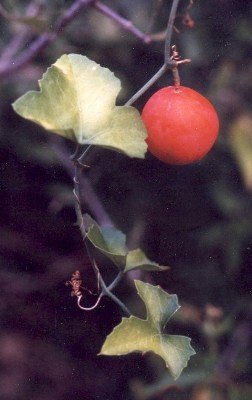Balsam Gourd
by Valerie (April 30, 2002)
 When I identified balsam gourd (Ibervillea lindheimeri) through several books and on-line sources, I was very surprised to find that it is in the gourd and cucumber family. Just seeing the fruits and leaves, I had mistakenly thought it might be related to passionflowers. I opened one fruit and it had the slightly sweet smell and the fleshy gel-covered fat seeds of a passionflower. Even the texture of the fruit made me think of the wrong identification.
When I identified balsam gourd (Ibervillea lindheimeri) through several books and on-line sources, I was very surprised to find that it is in the gourd and cucumber family. Just seeing the fruits and leaves, I had mistakenly thought it might be related to passionflowers. I opened one fruit and it had the slightly sweet smell and the fleshy gel-covered fat seeds of a passionflower. Even the texture of the fruit made me think of the wrong identification.
As the vine is a beautiful and common perennial in this area (Edward's Plateau), it didn't take long to find out the real names and taxonomy. Common names include wild balsam, Lindheimer globeberry, Rio Grande globeberry, viper's herb and snake apple. I've not seen the flowers of this plant up close because I always find the plant by its bright fruits, which are produced late in the summer. Our plants are growing nicely this season, but are still young and haven't bloomed yet. After freezing back in the winter, they are a little slow in sprouting again, waiting until well into the warmer weather. Starting the vines from seed was easy but they are slow growers at first. The early leaves are rather ivy-like with practically straight edges, and they resemble several other vines. As the plant matures, the leaves become deeply notched and a bit more fleshy. The plants climb by producing tendrils and are often found intertwined in the foliage of shrubs and small trees. While the foliage itself is quite lovely, the brilliant fruits are a colorful added bonus late in the season. |